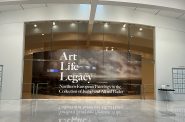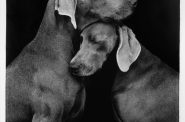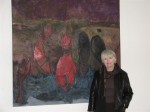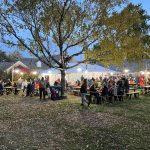Richard Knight
He lives in a “purplish” house on Morris Boulevard in Shorewood. His studio is in his converted garage. Many folks remember him as a former assistant at Tory Folliard Gallery in the Third Ward, a friendly chap always fully informed about the art and always happy to share his particularly sharp insights. For a time I knew him as Debra Brehmer’s assistant at the Portrait Society Gallery, the chap who worked with her on the Bernard Gilardi estate project.
It’s easy for an artist to get lost in the tsunami of jobs necessary to keep body and soul together. Richard Knight has always had jobs, but has managed to keep the spirit of his art alive. Over the years he’s had many exhibits, both local and national, and in 2005 he received a $500 Mary Nohl Suitcase Export Fund award, which he used to ship work to the Philip Slein Gallery in St. Louis. Knight was raised in Omaha, but later moved to St. Louis. In the 80s, he stuck pretty much to the Midwest, graduating in 1986 with an MFA from Indiana University in Bloomington, and prior to that, in 1981, with a BFA from Missouri State University in Springfield.
And so it is I find myself turning on to Morris Boulevard, seeking a purplish house. Knight waits, a bag of sweet parsley in hand, his garden of earthly delights newly planted with peas. At age 54, he retains the boyishness of youth, surrounded on this day with objects of his affection placed for inspiration in his studio. I grew up in the Nodaway Valley, some 70 miles east of Omaha, where rivers run. We share a preference for rivers running southbound, as opposed to oceans and lakes, and recall the whisper of cottonwoods lining the sandy banks of the Platte River. Our conversation meanders to childhood memories of building forts and roaming freely in “dangerous” places where imagination lived and for a fortunate few, continues to live.
Knight currently teaches at UW-Milwaukee, the Milwaukee Institute of Art and Design, and UW-Whitewater. It’s opened up a new world, far from the “gallery scene.” He observes that for the most part, our local gallery scene lacks leadership, and by that I assume he’s talking about a solid sense of direction and curatorial expertise. He currently is his own representative, but cautiously imagines working with an agent in the future. Nurtured by a family of four brothers and one sister, he was encouraged to make things.
Single objects find space on his studio shelves, and among the many, I find myself intrigued by a small, exquisitely rendered painting on linen. Titled “Blue Tumbler,” it speaks volumes, and is the total opposite of a huge painting, “Condensation.” Knight is modest and careful about what comes out of his mouth, so I am startled when he says, “It’s the best thing I’ve ever done.” He points out a small image of a tumbler positioned among the many objects in the work, where whirling vortices threaten to suck up everything in sight. Both chaotic and disciplined, the images hold fast despite the painterly turmoil. It’s a beauty built from living.
What happens to an artist at the moment of creation is beyond me and much has been written to try and explain the impossible. Knight’s work is thoroughly integrated with his life experiences. Does it get any better than that? No.
Addendum: Richard Knight Fun Facts, as told to Tom Strini
1. In the 1970s, Knight used to paint the sides of his high-school buddies’ vans.
2. He once skipped a high-school football game in order to attend the Tilles Art Fair. He had a piece in the fair. (“And I was a benchwarmer, anyway,” he said.)
3. Knight was drawn to the theater, and did tech and backstage work in high school productions and at a local dinner theater. He started college in theater tech, but quickly switched to studio art.
4. Among his many day jobs: Department-store window dresser, for Famous-Barr in St. Louis and Macy’s in Sacramento. (“We had a huge shop and built everything in Sacramento. Now, window dressing is a lost art. Everything comes from corporate, and you just assemble it.”) The experience made him a very tough critic of installation art.
5. At first glance, his 2-D work looks intuitive, playful, carnival-like. “There is that aspect, but it’s driven by ideas about evolutionary theory and how one thing becomes another. I study nature in all its forms. I’m interested in string theory — the universe is an orderly place, though we can’t see it day to day. I’m always looking for a structural thread that keeps the imagery contained. “There’s lots of motion, but it’s controlled so it doesn’t just fly off the page.”
6. Hints of rendered 3-D objects peek through the riotous, painterly abstraction. Knight likes to tinker and often uses discarded bits of metal and other materials and makes them into odd objects. (“For some reason, I resist calling them sculptures,” he said.) The elliptical wire-cage sort of shape exists in the real world — Knight made it. On the canvas, it’s maybe eight inches long. In real life, it’s four feet long.
7. The shield in Shield has a secret reference no one would ever guess. As a TCD insider, now you know: That pinkish object low in the center is based on the Falstaff beer logo. Falstaff, long closed, was a staple St. Louis brew in the mid-century. Knight’s father worked in the brewery’s advertising department.
8. Link to Richard Knight’s website.
Art
-
Exhibit Tells Story of Vietnam War Resistors in the Military
 Mar 29th, 2024 by Bill Christofferson
Mar 29th, 2024 by Bill Christofferson
-
See Art Museum’s New Exhibit, ‘Portrait of the Collector’
 Sep 28th, 2023 by Sophie Bolich
Sep 28th, 2023 by Sophie Bolich
-
100 Years Of Memorable Photography
 Sep 18th, 2023 by Rose Balistreri
Sep 18th, 2023 by Rose Balistreri



















